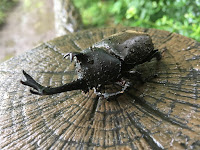Back in June, celebrating 50 posts, I mentioned ideas for new things on the blog one of which was reading recommendations. In the ensuing months, I've received quite a few suggestions from friends (thank-you!) so I'm going to put these together with my own favourites and introduce some must-read books by Japanese authors past and present. I'm hoping this will mark the start of a regular "book of the week" feature which (if all has gone to plan!) should be sitting to the right of this page as you read (assuming you're reading the web not the mobile version). You can click on the book image, as with all images on this page, to get more details and (often) see a preview on Amazon Japan. Since there are rather a lot of recommendations, I'm going to focus on the classics in this post and introduce some easy/casual reading in the next! I tried to limit myself to one book per author - not always successfully - but if you have other suggestions - or authors I've missed - please do let me know! Note that publishing dates are for the Japanese original.


Starting off with the classic of classics, I have to mention Shikibu Murasaki, the female author of the world's first (modern) novel
The Tale of Genji. Written in the 11th century, even Japanese struggle to read the original (it's studied in schools like Shakespeare is in the UK) but the translation by Royall Tyler is the go-to version (left). Be warned, it can be rather racy, focusing as it does on the protagonist's romantic affairs and entanglements; moreover, characters are not named, since this was considered rude in Heian court society! For a more accessible (and less explicit!) read, the 13-set
manga version by Waki Yamato (right) has wonderful illustrations and becomes the very first "book of the week" (though, unfortunately, only partially translated into
English at this time).



Moving into the 20th century, Natsume Soseki's (1905)
I am a Cat is a gorgeous, light, and satirical read which is in stark contrast to his 1914 deep and dark
Kokoro (Heart). Shusaku Endo's 1957
The Sea and the Poison is a heavy but honest and moving account about medical experiments on a captured American airman during the war, a story apparently inspired by true events. Nobel-prize winner Kenzaburo Oe's
A Personal Matter (1964) is the first of a series of works based on aspects of his disabled son Hikari's life; the feelings of guilt and responsibility are beautifully described.



More recently, the first and undoubtedly most famous novel by Banana Yoshimoto - pen name of Mahoko Yoshimoto - is her 1988 Kitchen, which has a distinctly youthful, even Western, slant as it deals with food, love, and gender. Finally, there is Haruki Murakami, the extremely talented and prolific writer who is surrounded by a buzz of "will he/won't he win the Nobel Prize for Literature" gossip each October here in Japan. My recommendation is his (1994)
Wind-Up Bird Chronicle which is a surreal story involving a lost cat, the supernatural, and a collection of fantastical, sometimes romantically involved, dead-beats that also broaches controversial subjects such as the
emptiness of contemporary politics and Japan's WWII aggression. Happy reading!


































